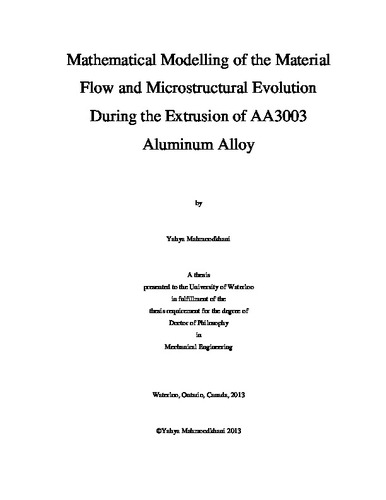| dc.contributor.author | Mahmoodkhani, Yahya | |
| dc.date.accessioned | 2013-09-25 16:42:32 (GMT) | |
| dc.date.available | 2014-06-04 05:00:46 (GMT) | |
| dc.date.issued | 2013-09-25T16:42:32Z | |
| dc.date.submitted | 2013-09-18 | |
| dc.identifier.uri | http://hdl.handle.net/10012/7905 | |
| dc.description.abstract | A comprehensive mathematical model of the hot extrusion process for aluminum alloys has been developed and validated. The model is capable of predicting the material flow behaviour and microstructure evolution that occurs in aluminum alloy AA3003 during extrusion. The plasticity module was developed using a commercial finite element package, DEFORM, a transient Lagrangian model which couples the thermal and deformation phenomena and is able to predict the temperature, strain rate and strain distribution in the billet/extrudate at any position in the container and die. Validation of the model against industrial data indicated that it gave excellent predictions of the pressure and temperature history during extrusion. Material flow effects during extrusion such as surface cladding (a transverse weld defect) as one billet is fed in after another through the die were also well predicted.
The results of the FEM model for material flow and thermomechanical history were post processed using MATLAB software to predict the grain deformation and stored energy in the extruded material as well as the thickness and extent of the transverse weld defect. Finally, the model predictions for microstructure and transverse weld were compared to microstructure observations.
The stored energy or driving pressure for Static Recrystallization (SRX) and Geometric Dynamic Recrystallization (GDRX) and how they are influenced by extrusion parameters were investigated using the mathematical model and experimental measurements. The experimental measurements for grain thickness and microstructural features made using Electron Back Scattered Diffraction (EBSD) technique and optical microscope show good agreement with model predictions. The mathematical model was then used to assess the effect a change in die design would have on the flow behaviour of the material during extrusion and on the transverse weld that forms. | en |
| dc.language.iso | en | en |
| dc.publisher | University of Waterloo | en |
| dc.subject | Extrusion | en |
| dc.subject | Microstructure | en |
| dc.subject | Aluminum Alloy | en |
| dc.subject | Modelling | en |
| dc.title | Mathematical Modelling of the Material Flow and Microstructural Evolution During the Extrusion of AA3003 Aluminum Alloy | en |
| dc.type | Doctoral Thesis | en |
| dc.pending | true | en |
| dc.subject.program | Mechanical Engineering | en |
| dc.description.embargoterms | 1 year | en |
| uws-etd.degree.department | Mechanical and Mechatronics Engineering | en |
| uws-etd.degree | Doctor of Philosophy | en |
| uws.typeOfResource | Text | en |
| uws.peerReviewStatus | Unreviewed | en |
| uws.scholarLevel | Graduate | en |

